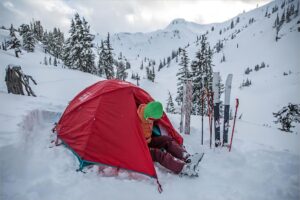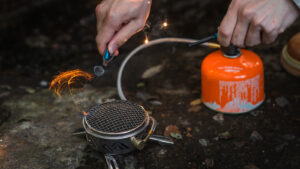
Essential Gear for Winter Camping
The most important guideline of winter camping is to keep dry and comfortable. When you’re out in the cold for lengthy periods of time, having the correct clothing for your trip might be important to your enjoyment.
Winter Camping Gear
Winter camping equipment is comparable to that required for backpacking but with a focus on warmth and hardiness. Here are some specifics on the main items:
Tent: A shelter that can resist cold weather is essential. When choosing a tent for winter camping, keep the following aspects in mind:
A typical 3-season backpacking tent can work if you’re camping below tree line and don’t expect particularly bad weather.
- For high winds and heavy snowfall, a4-season tent is recommended. 4-season tents feature stronger poles and heavier materials than 3-season tents, allowing them to endure strong winds and high snow loads. They also feature less mesh and rainflies that extend near to the ground to keep whirling snow out.
- You’ll want some extra space.It’s a good idea to acquire a tent that can accommodate one more person than the number of people sleeping in it (for example, a 3-person tent for two people). This allows you to store your goods inside, safe from the outdoors.
Backpack: Winter camping and backpacking necessitates more gear and thicker clothes, so you may need to utilize a bigger pack than you would in the summer. Pack as light as possible, but always be prepared for cold circumstances. For a 2- to 4-day excursion, here are some general guidelines:
Lightweight: minimum 65-liter (3,967 cubic inch) pack.
Deluxe: minimum 80-liter (4,882 cubic inch) pack.
If you want to carry skis or snowshoes, be sure your pack includes lash points or other means of securing these bulky goods.
Sleeping Bag:
It’s a good idea to use a bag that’s rated at least 10°F lower than the coldest temperature you expect to face on chilly nights to ensure comfort. If you get too hot, you can always vent the bag.
Consider the following while purchasing a sleeping bag:
- Cold-weather bags are filled with a lot of goose down or synthetic insulation. Due to its greater warmth-to-weight ratio, down is a popular choice. Just keep it dry (wet down loses most of its insulating qualities).
- Winter bags are differentiated by draft tubes behind the zippers, draft collars above the shoulders, and hoods to assist in retaining the heat in the bag.
- If you are unsure whether your sleeping bag is warm enough, add a sleeping bag liner. These provide additional warmth while also reducing wear and keeping your luggage cleaner. The additional layer might offer 5 – 25°F of warmth.
Sleeping Pad: A sleeping pad is necessary for insulation and comfort. Here’s some useful sleeping pad information:
Use two pads: To avoid losing body heat on icy surfaces when winter camping, use two full-length pads. To gain optimum insulation from the chilly ground, use a closed-cell foam pad next to the ground and a self-inflating pad on top. The foam pad also provides protection if the self-inflating pad is ruptured.
Consider R-value: Pads are assessed according to their R-value, which ranges between 1.0 and 8.0. The greater the R-value, the better the insulation. All-season or winter pads typically have an R-value of around 4.0 or greater.
Backpacking Stove: For winter camping, most liquid-fuel stoves and some canister stoves are suitable.
White gas, which burns hot and clean and works well in below-freezing conditions, powers liquid-fuel stoves. However, they are heavier and take longer to heat up than canister stoves, and you must usually prime them before you can cook. Some multi-fuel stoves may also run on unleaded gasoline, kerosene, jet fuel, and/or diesel, making them perfect for international travel.
Canister stoves are compact, light, and quick to heat up, but not all of them operate well in cold weather. If you want to use a canister stove for winter camping, be sure it includes a built-in pressure regulator. In cold temperatures, canisters might depressurize and produce a weak flame. A pressure regulator can be useful in this situation. Store your fuel canister in your sleeping bag at night and in a jacket pocket while you’re at camp and ready to cook.
Snowshoes, skis or a snowboard: Hiking is a great method to move about if there’s only a few inches of snow on the ground (if the trails are icy, consider using winter traction gear like crampons). However, if you’re going to a snowy location, you’ll need some sort of float to make navigation simpler. Here are your primary options:
Snowshoes: Snowshoes are definitely the greatest option if you don’t ski or snowboard. Snowshoeing, like hiking, is a straightforward sport to learn.
Skis: Cross-country touring skis are ideal for mild terrain. Bring your backcountry skis for the tougher slopes.
Snowboard: You can utilize a split board that divides in two lengthwise, transforming it into skis for ascending slopes (at the top, you put the board back together and snowboard down). You may also carry a normal snowboard in your bag and trek uphill with snowshoes.
Base Layer top:
A base layer top retains heat and wicks moisture away from your body, but it should also be soft, warm, and flexible. Moisture-wicking textiles such as merino wool or synthetic are suitable. Wool is recognized for its antimicrobial and odor-preventing properties, although synthetics dry faster.
Water Bottle / Hydration System
Even if you shouldn’t be sweating, winter air can be exceedingly dry, and your breath can lose a lot of moisture. You should carry water with you to remain hydrated. Whether you carry a bottle or a reservoir, you’ll want to keep your water from freezing, so choose insulated options.
ODM service
Looking for reliable wholesale outdoor equipment? At Deermaple, we specialize in ODM service, offering high-quality and innovative gear tailored to your needs.
If you are interested in outdoor gear wholesale, please contact us.














